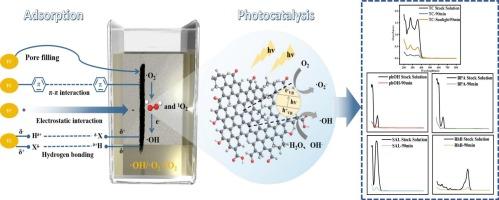通过商品活性炭纤维内在的协同吸附-光催化,经济高效地降解溶解的有机污染物
IF 6.9
2区 材料科学
Q2 CHEMISTRY, PHYSICAL
引用次数: 0
摘要
本研究探讨了粘基活性炭纤维(ACFs)固有的光催化活性及其在可见光下的协同吸附-光催化机理。对两种商用ACFs进行预处理,其中一种用硝酸进一步氧化。四环素(TC)是典型污染物。结果表明,吸附量与缺陷密度呈正相关,而光催化性能与sp2杂化碳含量有关。90 min后,吸附和联合吸附-光催化的TC去除率分别为17.6 %/91.3 %和7.3 %/85.5 %。矿化效果良好,COD/TOC去除率分别为85.1 %/85.4 %和73.4 %/75 %。ACFs在较宽的pH范围(3-9)内保持了较高的TC降解率,在1.0 L/min的曝气速率下,优质样品在20 min内达到99.4 %的TC去除率。OH和O2−是主要的活性氧。通过高温煅烧,材料表现出优异的再生能力。实际应用测试证实了它们在阳光下和对抗一系列有机污染物的有效性。这些结果突出了原始粘基ACFs作为低成本、可持续的高级废水处理材料的潜力。本文章由计算机程序翻译,如有差异,请以英文原文为准。

Cost-effective and efficient degradation of dissolved organic pollutants via intrinsic synergistic adsorption-photocatalysis of commercial activated carbon fiber
This study explores the intrinsic photocatalytic activity of viscose-based activated carbon fibers (ACFs) and their synergistic adsorption-photocatalysis mechanism under visible light. Two commercial ACFs were pretreated, with one further oxidized using nitric acid. Tetracycline (TC) served as the model pollutant. Results revealed that adsorption capacity was positively correlated with defect density, while photocatalytic performance depended on the sp2-hybridized carbon content. After 90 min, TC removal efficiencies for adsorption and combined adsorption-photocatalysis were 17.6 %/91.3 % and 7.3 %/85.5 %, respectively. Excellent mineralization was also achieved, with COD/TOC removal rates of 85.1 %/85.4 % and 73.4 %/75 %. ACFs maintained high TC degradation over a wide pH range (3–9), and the superior sample achieved 99.4 % TC removal within 20 min at an aeration rate of 1.0 L/min.  OH and
OH and  O2− were identified as the dominant reactive oxygen species. The materials exhibited excellent regeneration capability through high-temperature calcination. Practical application tests confirmed their effectiveness under sunlight and against a range of organic pollutants. These results highlight the potential of pristine viscose-based ACFs as low-cost, sustainable materials for advanced wastewater treatment.
O2− were identified as the dominant reactive oxygen species. The materials exhibited excellent regeneration capability through high-temperature calcination. Practical application tests confirmed their effectiveness under sunlight and against a range of organic pollutants. These results highlight the potential of pristine viscose-based ACFs as low-cost, sustainable materials for advanced wastewater treatment.
 OH and
OH and  O2− were identified as the dominant reactive oxygen species. The materials exhibited excellent regeneration capability through high-temperature calcination. Practical application tests confirmed their effectiveness under sunlight and against a range of organic pollutants. These results highlight the potential of pristine viscose-based ACFs as low-cost, sustainable materials for advanced wastewater treatment.
O2− were identified as the dominant reactive oxygen species. The materials exhibited excellent regeneration capability through high-temperature calcination. Practical application tests confirmed their effectiveness under sunlight and against a range of organic pollutants. These results highlight the potential of pristine viscose-based ACFs as low-cost, sustainable materials for advanced wastewater treatment.
求助全文
通过发布文献求助,成功后即可免费获取论文全文。
去求助
来源期刊

Applied Surface Science
工程技术-材料科学:膜
CiteScore
12.50
自引率
7.50%
发文量
3393
审稿时长
67 days
期刊介绍:
Applied Surface Science covers topics contributing to a better understanding of surfaces, interfaces, nanostructures and their applications. The journal is concerned with scientific research on the atomic and molecular level of material properties determined with specific surface analytical techniques and/or computational methods, as well as the processing of such structures.
 求助内容:
求助内容: 应助结果提醒方式:
应助结果提醒方式:


